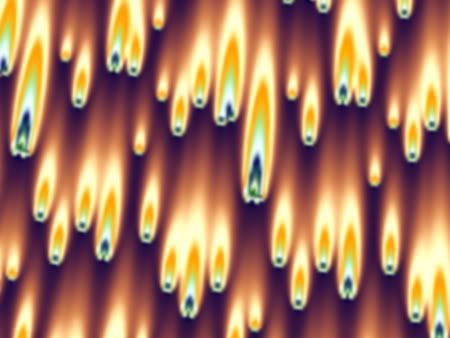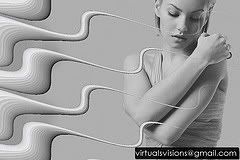Orbit Trap recently passed 100,000 hits. Tim and I would like thank all of our readers for your ongoing support (or lack thereof), and we both look forward to exploring fractal art "to its hiding place," as
Dr. Frankenstein says, in 2009.
I thought I'd begin the new year by dispelling an apparent misconception that I hate everything. I certainly do not. In fact, I see fractal and digital art that I like all the time. Here are a couple examples:

2 Architects #4 by Jürgen Schwietering
I've long enjoyed Jürgen Schwietering's amazing images. They are probably closer to algorithmic art than fractal art, but they definitely display similar iterative-recursive properties. His images are based on a program he wrote for simulating the growth of crystals, and the resulting art reveals pattern formations that bring to mind geological erosion and other maze-like, unsteady kinetics. The blueprint intricacy of lines and shapes is sometimes enhanced by the use of color, as in #17 dots 1, and Schwietering occasionally blends photographs seamlessly into his graphics, as in his amazing Self-Portrait.
Schwietering appears to be a Renaissance Man of wide and varied interests: photography, computer programming, video broadcasting, languages (fluent in four with "good notions" of two others), Zen, music, travel, snowboarding, surfing, and the list goes on. His graphics site hasn't been updated since 2004, so I guess he's been otherwise engaged in recent years. Here's hoping he surfs back eventually to create more of his algorithmic visions. Until then, I'll be waiting patiently and continuing to frequent his standing museum.

Sky Bolts by Vicky Brago-Mitchell
Vicky Brago-Mitchell, recently commenting on OT about several images in the most recent Fractal Universe Calendar, told me that "of course you wouldn't like mine any better." But don't be so sure.
Brago-Mitchell has been making fractals for a long time. Her web site currently has 123 galleries. Quantity does not equal quality, true, but Brago-Mitchell has learned a few things over the years. Mostly, she lets her fractals breathe. Although she works mostly in UF, she's resisted the commonly used multiple pancake method of composition -- as if grasping that complexity doesn't automatically mean artistically improved. Instead, Brago-Mitchell's compositions rest in single-digit layers that are moved into Photoshop for enhancement. This methodology brings out the light and shadows in the image above to further complement the feeling of motion. Brago-Mitchell also understands that sometimes what is not seen becomes integral, and she leaves expanses of darkness and shadow and thus allowing absence to shift a viewer's perspective -- as in "Lantern" (look how the light diffuses) or "Seaweed" (where the recursive leaf forms disappear in shadows). Mitchell also likes to play with varied forms and formulas like the Gaussian diamonds of "Bazaar" or the Torus underwater vines of "Expectation." And the four images I've cited here are taken from only two galleries. There are still 121 others to explore.
Although some of Brago-Mitchell's more conventional spiral stuff makes me shrug, she has a good eye and isn't afraid to use the comfort zone her experience brings to use familiar techniques to bring off fresh discoveries. Like Schwietering, Brago-Mitchell is a colorful personality with multiple past and present interests -- student body president candidate at Stanford, stripper, Japanese translator, elementary school teacher. Like Stephen Ferguson, Brago-Mitchell has an interest in putting fractal animations to music (her husband, John, composes the music). She also keeps an active blog where she isn't afraid to air her political views, and I admire her for that. Personally, I'd like to see her politics creep now and then into her art.

Art_2903 by Arte em Fotos, Fractais e Photoshop
Then again, I don't like everything. Welcome to VirtualVisions, a company more than happy to teleport (for a fee) you and your loved ones and your pets and even your stuff into a netherworld of fractal backdrops. The process is described on a NFO page on the web site:
We beautify your digital photos through an artistic application of graphics called fractals, from our unique creation, resulting in excellent adornment of your photos as you can see on this gallery.
The application overlaps, partial, or completely, the original background of the photograph, creating a seamless integration of the photo main subject with the harmonious background, transforming your photos in true and agreable [sic] artistical [sic] masterpiece!
The only description on VirtualVisions' profile is "male." This is no surprise since nearly all of the victims trapped in VV's fractal phantom zones are shapely female models. Pity the woman in the image above who seems to have inexplicably wandered into a Japanese tentacle rape anime. And doesn't your heart go out to this bathing beauty who apparently dove into deeper recursive waters than she planned? And what's to be the fate of this woman who looks more boxed in than Custer? I suppose we can at least be grateful that VV's models retain remnants of their clothing. Some women who meander into such "fractal universes" are not so lucky. I find it despicable that fractals are used for such objectification. Such work not only degrades women; it degrades our art form
But VV wants to make more than fractal-glamour-photographic-fusions. Go on and lock your pets in these fractalized (like caramelized) dimensions. Here's a space where no monkey has gone before. And what's the deal with this:

Yes, I'll have a venti skinny latte. Hold the protein and energy, though, and substitute PCP instead.
Art_06198 by Arte em Fotos, Fractais e Photoshop
Here's another problem. This kind of "work" continues to perpetuate the stereotype that fractal art is little more than a trippy back projection for a Grateful Dead concert. It strains to make phony far out karmic cosmic associations -- you know, like the Fractal "Universe" Calendar. Buying into this pigeonholed vision of fractal art won't make your photos an "artistical masterpiece." It will, however, immediately turn them into schlock.
Mark Townsend once noted in an OT comment that fractal art should not be judged by its worst examples, and I agree. But there are sound reasons why Tim and I expressed concerns over the image importation features built into Ultra Fractal 5. Although VV appears to do his fractal teleportation using Photoshop, UF5 will surely allow such exploitation and way-out bogusness to further proliferate.
I don't know whether VV's commercial venture will succeed, but I know that what he's doing is not fractal art. It's some of the worst fractal kitsch I've seen to date.
Tags: fractal, fractals, fractal art, fractal blog, fractal kitsch, fractal phantom zone, jurgen schwietering, vicky blago-mitchell, virtualvisions, help i've fallen into a fractal and i can't get up, cruelanimal, orbit trap













